2012 TOYOTA AURIS key battery
[x] Cancel search: key batteryPage 7 of 750

5
1
8 7
6
5
4
3
2
UK_AURIS/AURIS_HV_EE (OM12E33E)6-1. Maintenance and care
Cleaning and protecting
the vehicle exterior ..........474
Cleaning and protecting
the vehicle interior ...........478
6-2. Maintenance
Maintenance
requirements....................481
6-3. Do-it-yourself
maintenance
Do-it-yourself service
precautions ......................484
Hood ..................................488
Positioning a floor jack .......490
Engine compartment..........492
12-volt battery ....................514
Tires ...................................519
Tire inflation pressure ........522
Wheels ...............................524
Air conditioning filter ..........526
Wireless remote control/
electronic key battery.......529
Checking and replacing
fuses ................................532
Light bulbs .........................5557-1. Essential information
Emergency flashers .......... 572
If your vehicle has to
be stopped in an
emergency ...................... 573
7-2. Steps to take in an
emergency
If your vehicle needs to
be towed ......................... 575
If you think something is
wrong .............................. 583
Fuel pump shut off
system............................. 584
If a warning light turns
on or a warning buzzer
sounds ............................ 585
If a warning message is
displayed ......................... 599
If you have a flat tire
(vehicles with a
spare tire) ........................ 626
If you have a flat tire
(vehicles with an
emergency tire puncture
repair kit) ......................... 638
If the engine will not
start ................................. 664
If the hybrid system will
not start ........................... 666
6Maintenance and care7When trouble arises
Page 8 of 750
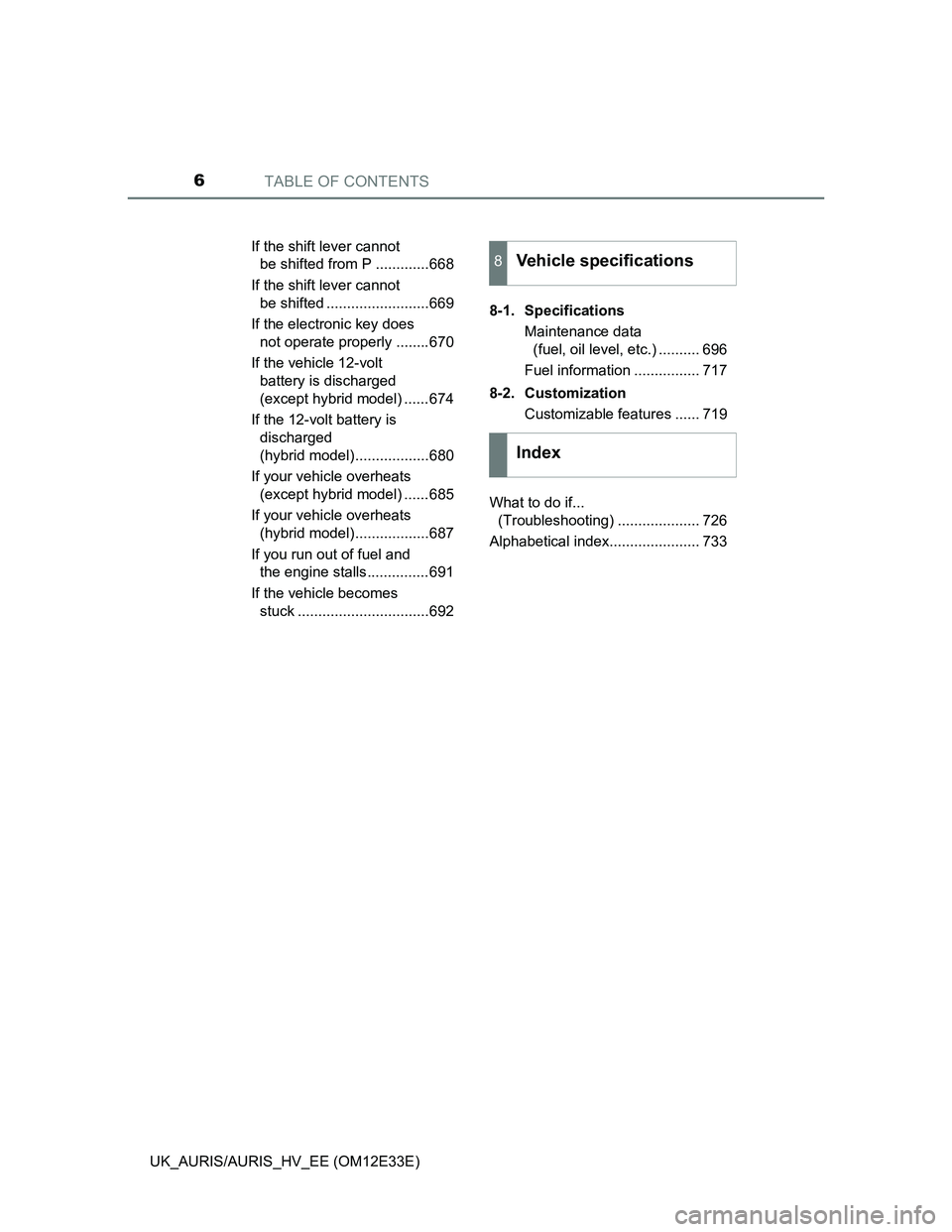
TABLE OF CONTENTS6
UK_AURIS/AURIS_HV_EE (OM12E33E)If the shift lever cannot
be shifted from P .............668
If the shift lever cannot
be shifted .........................669
If the electronic key does
not operate properly ........670
If the vehicle 12-volt
battery is discharged
(except hybrid model) ......674
If the 12-volt battery is
discharged
(hybrid model)..................680
If your vehicle overheats
(except hybrid model) ......685
If your vehicle overheats
(hybrid model)..................687
If you run out of fuel and
the engine stalls...............691
If the vehicle becomes
stuck ................................6928-1. Specifications
Maintenance data
(fuel, oil level, etc.) .......... 696
Fuel information ................ 717
8-2. Customization
Customizable features ...... 719
What to do if...
(Troubleshooting) .................... 726
Alphabetical index...................... 733
8Vehicle specifications
Index
Page 107 of 750
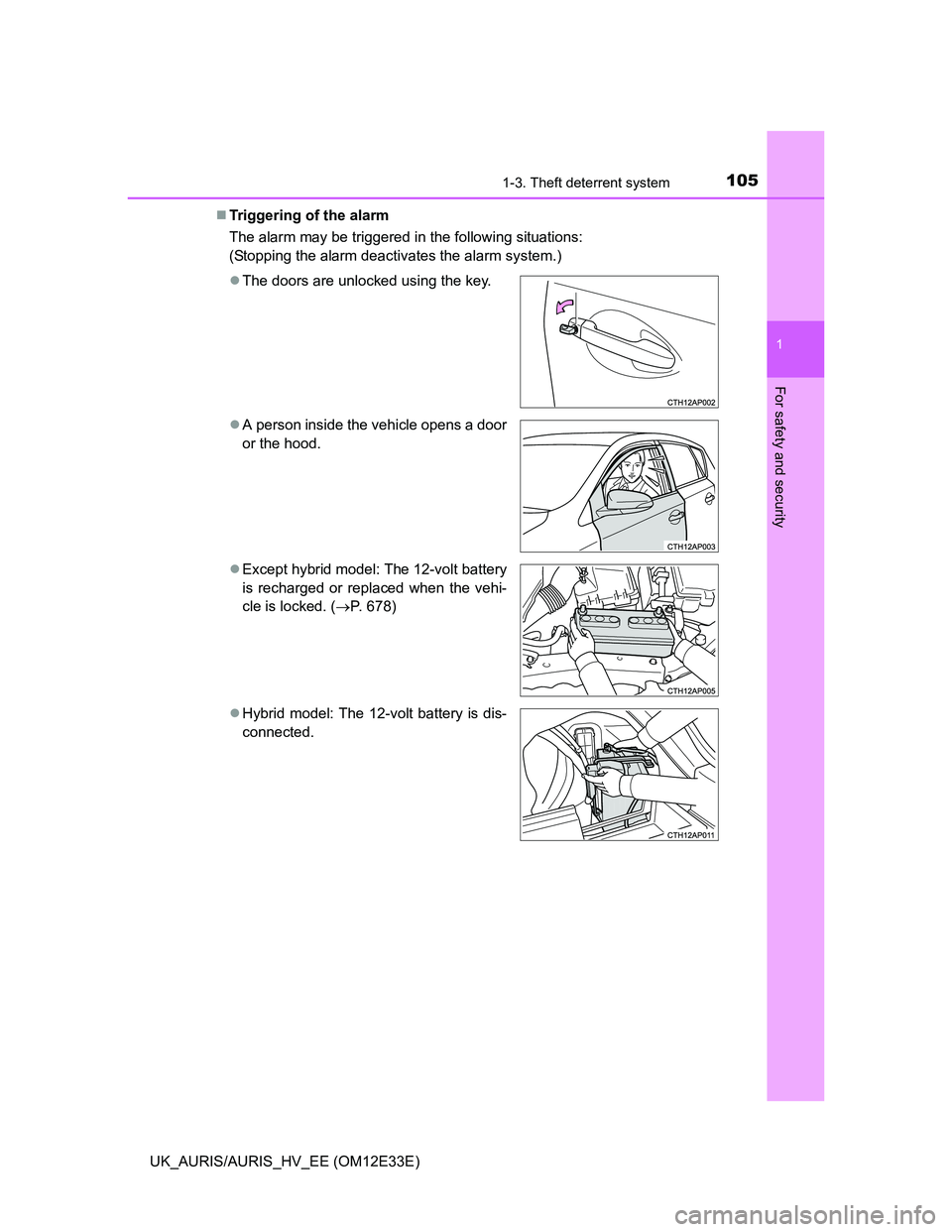
1051-3. Theft deterrent system
1
For safety and security
UK_AURIS/AURIS_HV_EE (OM12E33E)Triggering of the alarm
The alarm may be triggered in the following situations:
(Stopping the alarm deactivates the alarm system.)
The doors are unlocked using the key.
A person inside the vehicle opens a door
or the hood.
Except hybrid model: The 12-volt battery
is recharged or replaced when the vehi-
cle is locked. (P. 678)
Hybrid model: The 12-volt battery is dis-
connected.
Page 108 of 750
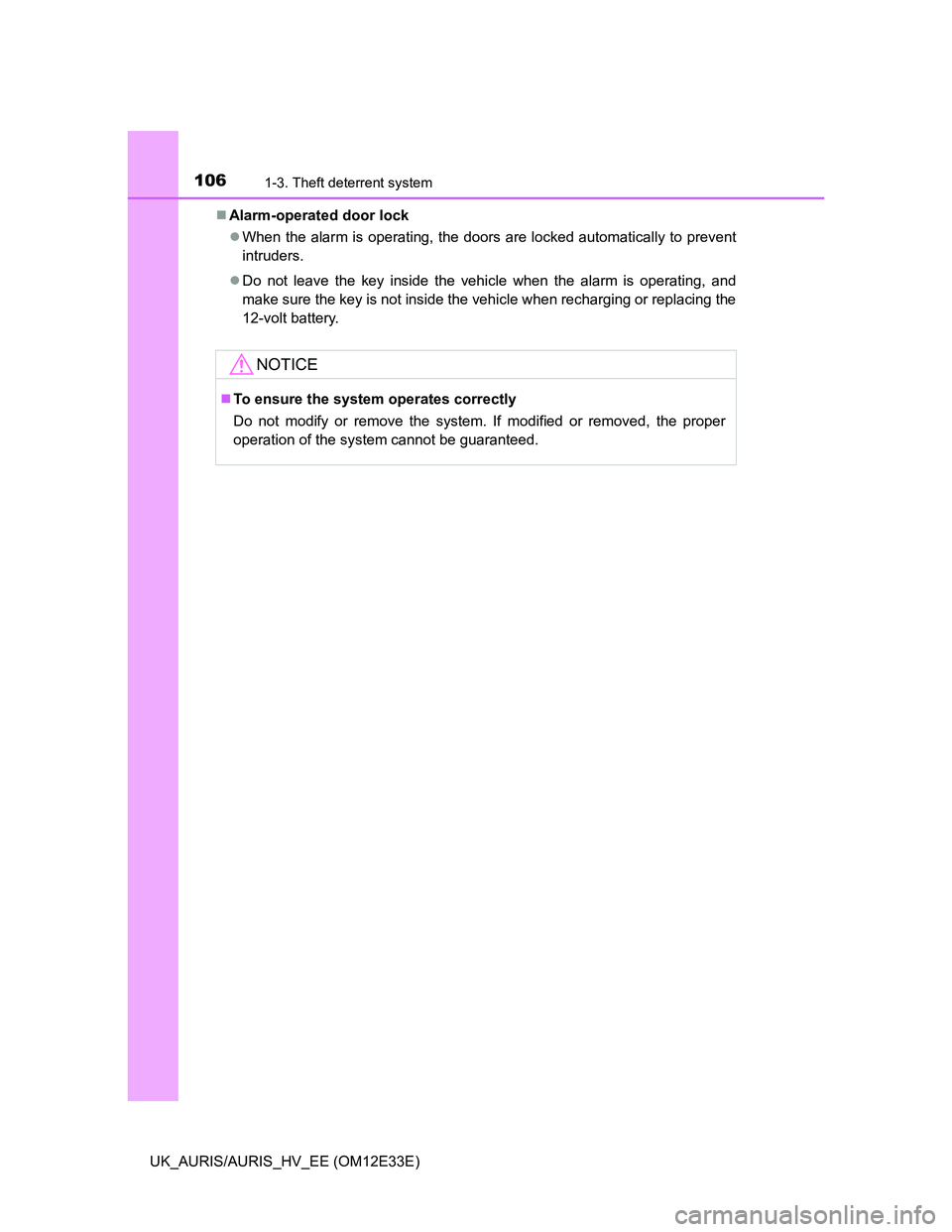
1061-3. Theft deterrent system
UK_AURIS/AURIS_HV_EE (OM12E33E)Alarm-operated door lock
When the alarm is operating, the doors are locked automatically to prevent
intruders.
Do not leave the key inside the vehicle when the alarm is operating, and
make sure the key is not inside the vehicle when recharging or replacing the
12-volt battery.
NOTICE
To ensure the system operates correctly
Do not modify or remove the system. If modified or removed, the proper
operation of the system cannot be guaranteed.
Page 151 of 750
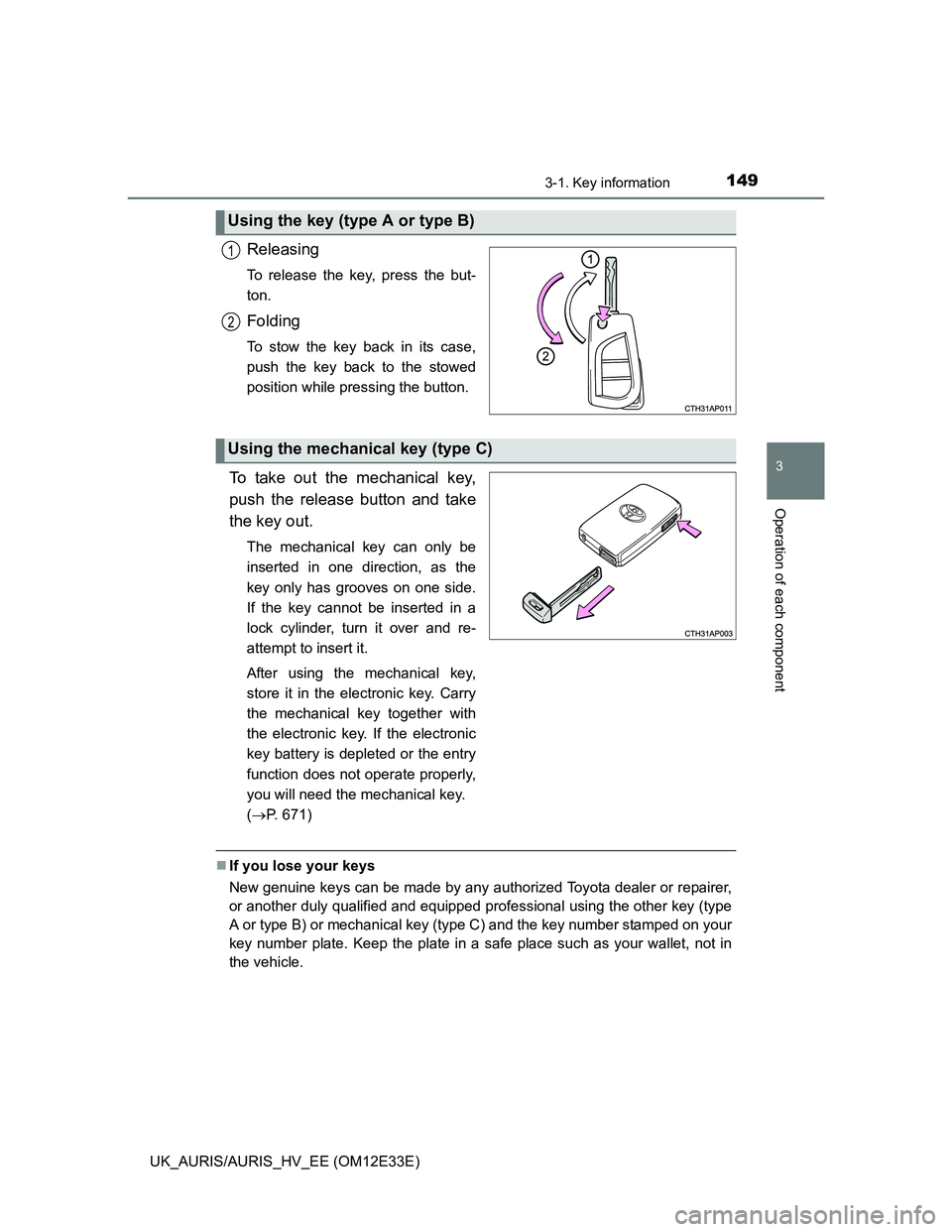
1493-1. Key information
UK_AURIS/AURIS_HV_EE (OM12E33E)
3
Operation of each component
Releasing
To release the key, press the but-
ton.
Folding
To stow the key back in its case,
push the key back to the stowed
position while pressing the button.
To take out the mechanical key,
push the release button and take
the key out.
The mechanical key can only be
inserted in one direction, as the
key only has grooves on one side.
If the key cannot be inserted in a
lock cylinder, turn it over and re-
attempt to insert it.
After using the mechanical key,
store it in the electronic key. Carry
the mechanical key together with
the electronic key. If the electronic
key battery is depleted or the entry
function does not operate properly,
you will need the mechanical key.
(P. 671)
If you lose your keys
New genuine keys can be made by any authorized Toyota dealer or repairer,
or another duly qualified and equipped professional using the other key (type
A or type B) or mechanical key (type C) and the key number stamped on your
key number plate. Keep the plate in a safe place such as your wallet, not in
the vehicle.
Using the key (type A or type B)
1
2
Using the mechanical key (type C)
Page 159 of 750

1573-2. Opening, closing and locking the doors
UK_AURIS/AURIS_HV_EE (OM12E33E)
3
Operation of each component
Battery-saving function
The battery-saving function will be activated in order to prevent the electronic
key battery and the vehicle battery from being discharged while the vehicle is
not in operation for a long time.
In the following situations, the smart entry & start system may take some
time to unlock the doors.
• The electronic key has been left in an area of approximately 2 m (6 ft.) of
the outside of the vehicle for 10 minutes or longer.
• The smart entry & start system has not been used for 5 days or longer.
If the smart entry & start system has not been used for 14 days or longer,
the doors cannot be unlocked at any doors except the driver’s door. In this
case, take hold of the driver’s door handle, or use the wireless remote con-
trol or the mechanical key, to unlock the doors.
Electronic Key Battery-Saving Function
When battery-saving mode is set, battery
depletion is minimized by stopping the
electronic key from receiving radio waves.
Press twice while pressing and
holding . Confirm that the electronic
key indicator flashes 4 times.
While the battery-saving mode is set, the
smart entry & start system cannot be
used. To cancel the function, press any of
the electronic key buttons.
Page 160 of 750
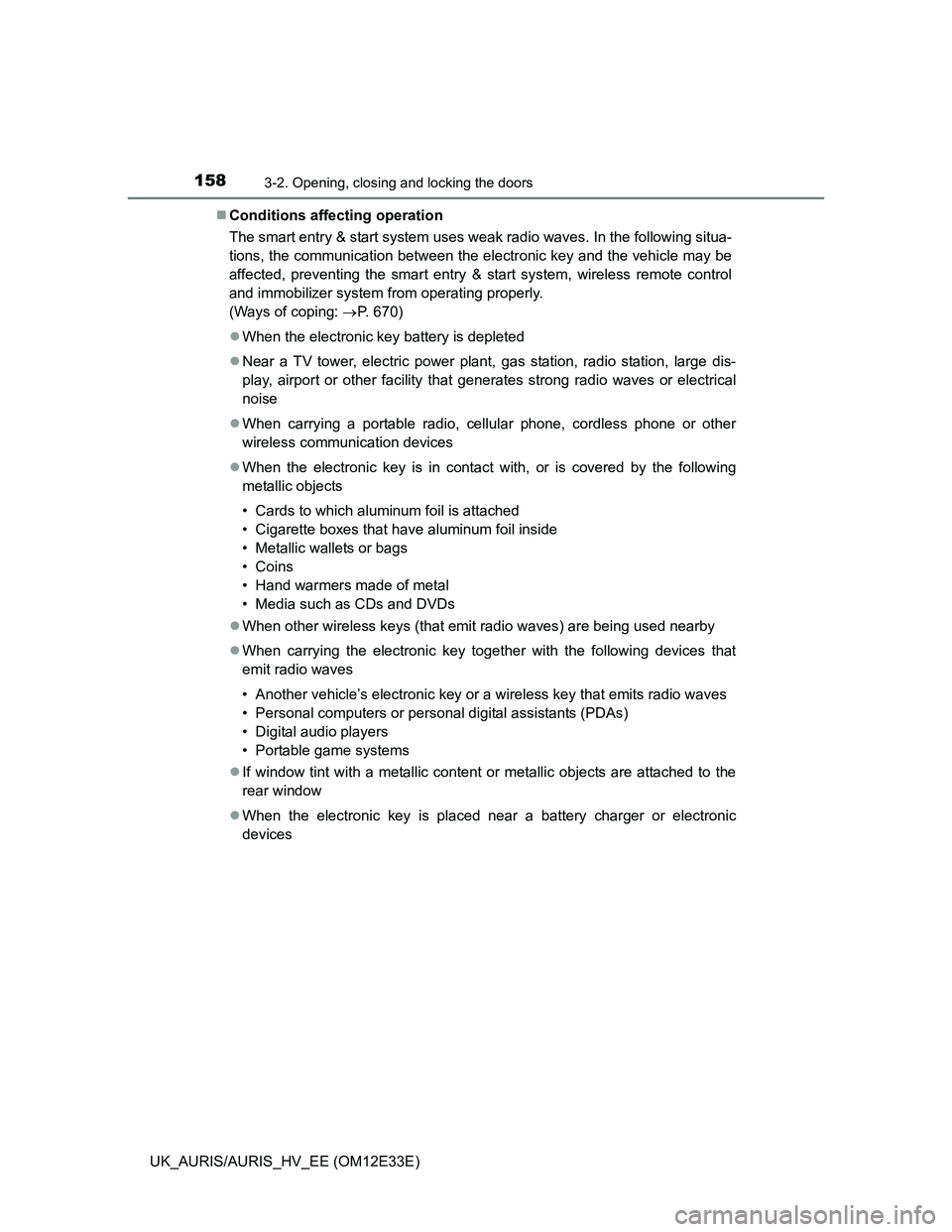
1583-2. Opening, closing and locking the doors
UK_AURIS/AURIS_HV_EE (OM12E33E)Conditions affecting operation
The smart entry & start system uses weak radio waves. In the following situa-
tions, the communication between the electronic key and the vehicle may be
affected, preventing the smart entry & start system, wireless remote control
and immobilizer system from operating properly.
(Ways of coping: P. 670)
When the electronic key battery is depleted
Near a TV tower, electric power plant, gas station, radio station, large dis-
play, airport or other facility that generates strong radio waves or electrical
noise
When carrying a portable radio, cellular phone, cordless phone or other
wireless communication devices
When the electronic key is in contact with, or is covered by the following
metallic objects
• Cards to which aluminum foil is attached
• Cigarette boxes that have aluminum foil inside
• Metallic wallets or bags
• Coins
• Hand warmers made of metal
• Media such as CDs and DVDs
When other wireless keys (that emit radio waves) are being used nearby
When carrying the electronic key together with the following devices that
emit radio waves
• Another vehicle’s electronic key or a wireless key that emits radio waves
• Personal computers or personal digital assistants (PDAs)
• Digital audio players
• Portable game systems
If window tint with a metallic content or metallic objects are attached to the
rear window
When the electronic key is placed near a battery charger or electronic
devices
Page 162 of 750

1603-2. Opening, closing and locking the doors
UK_AURIS/AURIS_HV_EE (OM12E33E)Note for locking the doors
Touching the door lock sensor while wearing gloves may delay or prevent
lock operation. Remove the gloves and touch the lock sensor again.
When the lock operation is performed using the lock sensor, recognition sig-
nals will be shown up to two consecutive times. After this, no recognition
signals will be given.
If the door handle becomes wet while the electronic key is within the effec-
tive range, the door may lock and unlock repeatedly. In that case, follow the
following correction procedures to wash the vehicle:
• Place the electronic key in a location 2 m (6 ft.) or more away from the
vehicle. (Take care to ensure that the key is not stolen.)
• Set the electronic key to battery-saving mode to disable the smart entry &
start system. (P. 157)
If the electronic key is inside the vehicle and a door handle becomes wet
during a car wash, a message may be shown on the multi-information dis-
play and a buzzer will sound outside the vehicle. To turn off the alarm, lock
all the doors.
The lock sensor may not work properly if it comes into contact with ice,
snow, mud, etc. Clean the lock sensor and attempt to operate it again.
Fingernails may scrape against the door during operation of the door han-
dle. Be careful not to injure fingernails or damage the surface of the door.
Note for the unlocking function
A sudden approach to the effective range or door handle may prevent the
doors from being unlocked. In this case, return the door handle to the origi-
nal position and check that the doors unlock before pulling the door handle
again.
Gripping the door handle when wearing a glove may not unlock the door.
If the door handle becomes wet while the electronic key is within the effec-
tive range, the door may lock and unlock repeatedly. In that case, follow the
following correction procedures to wash the vehicle:
• Place the electronic key in a location 2 m (6 ft.) or more away from the
vehicle. (Take care to ensure that the key is not stolen.)
• Set the electronic key to battery-saving mode to disable the smart entry &
start system. (P. 157)
If there is another electronic key in the detection area, it may take slightly
longer to unlock the doors after the door handle is gripped.
Fingernails may scrape against the door during operation of the door han-
dle. Be careful not to injure fingernails or damage the surface of the door.